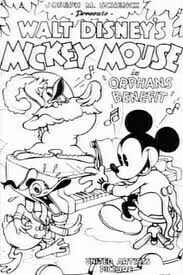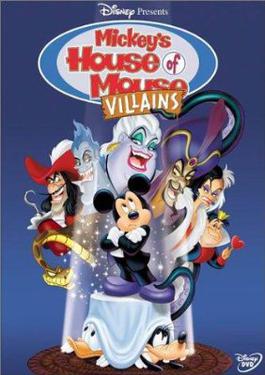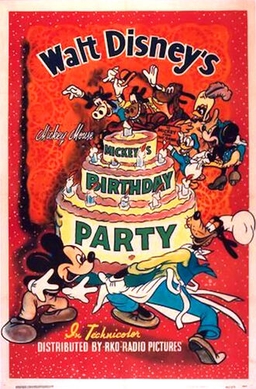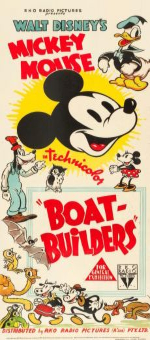
Pete is a cartoon character created by Walt Disney and Ub Iwerks of The Walt Disney Company. Pete is traditionally depicted as the villainous arch-nemesis of Mickey Mouse, and was made notorious for his repeated attempts to kidnap Minnie Mouse. Pete is the oldest continuing Disney character, having debuted in the cartoon Alice Solves the Puzzle in 1925. He originally bore the appearance of an anthropomorphic bear, but with the advent of Mickey in 1928, he was defined as a cat.

Mickey Mouse Works is an American animated television series produced by Walt Disney Television Animation featuring Mickey Mouse and his friends in a series of animated shorts. The first Disney television animated series to be produced in widescreen high definition, it is formatted as a variety show, with skits starring Mickey Mouse, Minnie Mouse, Donald Duck, Daisy Duck, Goofy, Pluto and Ludwig Von Drake while Horace Horsecollar, Clarabelle Cow, Morty and Ferdie Fieldmouse, Huey, Dewey and Louie, Chip 'n' Dale, Scrooge McDuck, Pete, Humphrey the Bear, J. Audubon Woodlore, Dinah the Dachshund, Butch the Bulldog, Mortimer Mouse, José Carioca, and Clara Cluck appear as supporting or minor characters. Musical themes for each character were composed by Stephen James Taylor with a live 12-piece band and extensive use of the fretless guitar to which the music of the series was nominated for an Annie Award in both 1999 and 2001. Most of the shorts from the series were later used in House of Mouse.

Minnie Mouse is a cartoon character created by The Walt Disney Company. As the longtime sweetheart of Mickey Mouse, she is an anthropomorphic mouse with white gloves, a red or pink bow, blue polka-dotted dress, white bloomers and low-heeled shoes occasionally with ribbons on them. The Mickey Mouse comic strip story "The Gleam" by Merrill De Maris and Floyd Gottfredson first gave her full name as Minerva Mouse, although this is seldom used.

The Mickey Mouse universe is a fictional shared universe which is the setting for stories involving Disney cartoon characters, including Mickey and Minnie Mouse, Donald and Daisy Duck, Pluto the pup and Goofy as the primary members, and many other characters related to them, being most of them anthropomorphic animals. The universe originated from the Mickey Mouse animated short films produced by Disney starting in 1928. Still, its first consistent version was created by Floyd Gottfredson in the Mickey Mouse newspaper comic strip. Real-world versions also exist in Disneyland and Tokyo Disneyland, called Mickey's Toontown.

Orphan's Benefit is an American animated short film produced by Walt Disney Productions in black-and-white. It was first released in 1934 and was later remade in Technicolor in 1941 under the corrected title Orphans' Benefit. The cartoon features Mickey Mouse and his friends putting on a vaudeville-style benefit show for a group of unruly orphans. It contains a number of firsts for Disney, including the first time in which Mickey Mouse and Donald Duck appear together, and was the 68th Mickey Mouse short film to be released, and the sixth of that year. It was also the cartoon which had the first story to be written that featured Donald Duck, though it was the second Donald Duck short to be produced and released, after The Wise Little Hen.

Mickey's House of Villains is a 2002 American direct-to-video animated comedy-horror film produced by Walt Disney Television Animation. It is based on the animated television series House of Mouse and serves as a stand-alone sequel to the direct-to-video animated film Mickey's Magical Christmas: Snowed in at the House of Mouse, starring Mickey Mouse, Donald Duck, Minnie Mouse, Goofy, Daisy Duck, and Disney Villains that appeared in past Disney productions. It was released on both VHS and DVD by Walt Disney Home Entertainment on September 3, 2002.

Mickey's Birthday Party is an American animated short film directed by Riley Thomson, produced by Walt Disney Productions and distributed by RKO Radio Pictures. The 114th short to feature Mickey Mouse, it was released on February 7, 1942. The animated film was directed by Riley Thomson and animated by Les Clark, James Moore, Ken Muse, Armin Shaffair, Riley Thompson, Bernie Wolf, and Marvin Woodward. It was the 116th short in the Mickey Mouse film series to be released, and the first for that year.

The Barn Dance is a Mickey Mouse short animated film first released on March 15, 1929, as part of the Mickey Mouse film series; it was the first of twelve shorts released during that year. It was directed by Walt Disney with Ub Iwerks as the head animator. The title is written as Barn Dance on the poster, while the full title is used on the title screen.
On Ice is a 1935 theatrical cartoon short in the Mickey Mouse film series, produced by Walt Disney Animation Studios. It was the 79th Mickey Mouse short film to be released, and the eighth of that year.

Building a Building is a 1933 American animated short film produced by Walt Disney Production and released by United Artists. A remake of the 1928 Oswald the Lucky Rabbit film Sky Scrappers, the cartoon depicts Mickey Mouse working at a construction site under the supervision of Peg-Leg Pete while Minnie Mouse is selling box lunches to the workers. It was directed by David Hand, his first directorial assignment at Disney, and features the voices of Walt Disney as Mickey, Marcellite Garner as Minnie, and Pinto Colvig as Pete. It was the 51st Mickey Mouse short film, and the first of that year.
Mickey's Surprise Party is a 1939 American animated short film directed by Hamilton Luske, produced by Walt Disney Productions and distributed by National Biscuit Company. It was the 105th short in the Mickey Mouse film series to be released, and the second for that year. Mickey's Surprise Party is the first cartoon with Mickey and Minnie Mouse in their current designs, created by animator Fred Moore.

Moving Day is a 1936 American animated short film produced by Walt Disney Productions and released by United Artists. The cartoon, set during the contemporary Great Depression, follows the antics of Mickey Mouse, Donald Duck, and Goofy as they frantically pack their belongings after being dispossessed from their home. The film was directed by Ben Sharpsteen and includes the voices of Walt Disney as Mickey, Clarence Nash as Donald, Pinto Colvig as Goofy, and Billy Bletcher as Sheriff Pete. It was the 85th Mickey Mouse short to be released, and the eighth of that year.

Boat Builders is an animated short film produced by Walt Disney, distributed by RKO Radio Pictures and released on February 25, 1938. The film was directed by Ben Sharpsteen and animated by Frenchy de Trémaudan, Louie Schmitt, Chuck Couch, Eddie Strickland, Clyde Geronimi, Paul Satterfield, Archie Robin, Don Patterson. It was the 99th short in the Mickey Mouse film series to be released, and the first for that year.

Hawaiian Holiday is a 1937 American animated short film produced by Walt Disney Productions and released by RKO Radio Pictures. The cartoon stars an ensemble cast of Mickey Mouse, Minnie Mouse, Pluto, Donald Duck, and Goofy while vacationing in Hawaii. The film was directed by Ben Sharpsteen, produced by John Sutherland and features the voices of Walt Disney as Mickey, Marcellite Garner as Minnie, Clarence Nash as Donald, and Pinto Colvig as Goofy and Pluto. It was Disney's first film to be released by RKO, ending a five-year distributing partnership with United Artists.

Pluto's Christmas Tree is a 1952 Mickey Mouse cartoon in which Pluto and Mickey cut down a Christmas tree that Chip n' Dale live in. It was the 125th short in the Mickey Mouse film series to be released, and the second for that year. While the chipmunks are usually antagonists of Donald Duck, they have pestered Pluto before, in Private Pluto (1943), Squatter's Rights (1946) and Food for Feudin' (1950).

Get a Horse! is a 2013 American animated comedy short film produced by Walt Disney Animation Studios and directed by Lauren MacMullan. Combining black-and-white hand-drawn animation and color computer animation, the short features the characters of the late 1920s Mickey Mouse cartoons.

Mickey's Service Station is a 1935 animated short film produced by Walt Disney Productions and released by United Artists. The film, which stars Mickey Mouse, Donald Duck, and Goofy as car mechanics, was also the final black-and-white appearance of Donald, Goofy, and Pete and the penultimate animated black-and-white film produced by Disney after Mickey's Kangaroo which was released later the same year. It was also the first team-up of the classic trio of Mickey, Donald, and Goofy. Mickey's Service Station was directed by Ben Sharpsteen, who at the time had directed only Silly Symphony shorts, and starred the voices of Walt Disney, Clarence Nash, Pinto Colvig, and Billy Bletcher. It was the 74th Mickey Mouse short film to be released, and the third of that year.
The Fox Hunt is a 1938 animated short film produced by Walt Disney Productions and released by RKO Radio Pictures. The film stars Donald Duck and Goofy on a traditional English fox hunt. Mickey and Minnie Mouse, Horace Horsecollar, and Clara Cluck also make brief cameos. The film was directed by Ben Sharpsteen and features the voices of Clarence Nash as Donald and Pinto Colvig as Goofy.

The Cactus Kid is a Mickey Mouse short animated film first released on May 10, 1930, as part of the Mickey Mouse film series. It was the eighteenth Mickey Mouse short to be produced, the third of that year.
The Riveter is a 1940 American Donald Duck short film directed by Dick Lundy and produced by Walt Disney. In the short film, Donald lands a job working high steel as a riveter for construction foreman Pete.

















